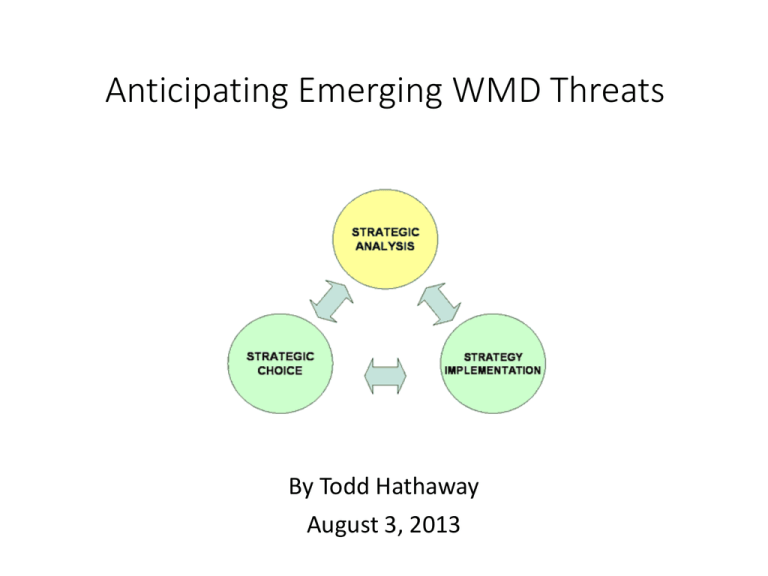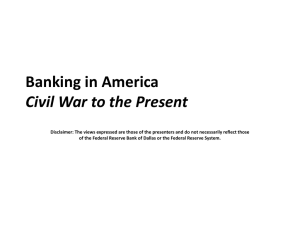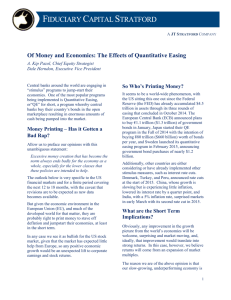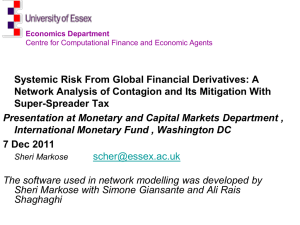3 year period - Project Avalon
advertisement

Anticipating Emerging WMD Threats By Todd Hathaway August 3, 2013 3-3-3 Transition Process Timeline • 3 month period – August thru October 2013 • Preparations for a 3-year “devolutionary fiscal environment” • 3 year period – November 2013 thru October 2016 • Implement a strategic dynamic decision modeling process through the 2016 election season • “Soft launch” crisis management plan during this period • Establish greater collaboration throughout one’s network • 3 decade period – FY 2017 thru FY 2046 • Reconstruction of the geopolitical and economic infrastructure • Help establish/maintain a stable multi-polar world dynamic 4/13/2015 2 Step One: Follow the Money 4/13/2015 3 * The Federal Reserve stated most recently that 7% unemployment is the benchmark to target an end to quantitative easing, and 6.5% unemployment would be a general guideline for when the Fed begins hiking interest rates. * The Federal Reserve is using the Bureau of Labor Statistics (BLS) unemployment data (below) to make this determination, and will vote in September for quantitative easing at revised levels below $85 billion/month. * Federal Reserve Chairman, Ben Bernanke, will formally announce the beginning of tapering of asset purchases by the Federal Reserve by Dec 2013. 10 9.8 9.6 9.4 9.2 9 8.8 8.6 8.4 8.2 8 7.8 7.6 7.4 7.2 7 6.8 6.6 6.4 6.2 6 Sep-09 Mar-10 Sep-10 Mar-11 Sep-11 Mar-12 Sep-12 Mar-13 Sep-13 Mar-14 Aug-14 y = -0.002x + 88.719 R² = 0.9681 4/13/2015 4 U.S. Debt rising as GDP remains stagnant • At the end of 2012, nearly $70.1 trillion (bottom, right) was owed in off-balance-sheet liabilities, in addition to the 'official' federal debts totaling $16.7 trillion as of May 2013 • For every job created, two Americans enroll in food stamps • Disposable income is declining as liabilities continue to rise 4/13/2015 5 * Central banks have created an unsustainable level of fiscal imbalance that cannot be corrected by reducing asset purchases without destabilizing the global derivatives market in the process. Japan bonds are the weakest link in the chain. * Exotic debt instruments are being utilized throughout the global financial marketplace to maintain historically low interest and mortgage rates, while nations importing U.S. debt and engaging in their own currency carry trade practices continue to struggle with the fallout from increasing levels of quantitative easing (devaluation) of their own currencies. * Once the Federal Reserve agrees to reduce levels of quantitative easing below the $85 billion monthly injections into the global economy, gov’t bond rates around the world will begin to escalate and capital controls will be implemented. 4/13/2015 6 * Future announcements by the Federal Reserve to reduce quantitative easing will have an immediate ripple effect in bond markets around the world (beginning with Japanese gov’t bonds) as international investors recognize that the current distribution of quantitative easing allocated to foreign banks exceeds U.S. bank holdings * Global liquidity will precipitously decline as the Federal Reserve ends dollar carry trade practices, resulting in declining GDP around the world 4/13/2015 7 * In 2011, the Financial Stability Board (FSB) released a list of 29 “too big to fail” corporations currently operating around the world. * According to the FSB, these institutions are considered to be “systemically important financial institutions,” and a failure of any one of these corporations could result in “financial systemic failure.” * 17 are headquartered in Europe, 8 are in the U.S., and 4 are in Asia: Bank of America Deutsche Bank Morgan Stanley Bank of China Goldman Sachs Nordea Bank of New York Mellon Group Crédit Agricole Royal Bank of Scotland Banque Populaire CdE HSBC Santander Barclays ING Bank Société Générale BNP Paribas JPMorgan Chase State Street Citigroup Lloyds Banking Group Sumitomo Mitsui FG Commerzbank Mitsubishi UFJ FG UBS Credit Suisse Mizuho FG Unicredit Group Wells Fargo 4/13/2015 8 * A sufficient fraction of both domestic and foreign interest rate swap derivatives contracts held by these large banks will turn toxic as interest rates increase, compromising the bottom line of all big banks currently holding trillions of dollars each in interest rate swap derivatives contracts. * A failure of any one of the “too big to fail” banking institutions would result in electronic bank runs, further eroding the ability of banks to provide liquidity and increasing the likelihood of extended bank holidays. * What is most likely to create a bank holiday scenario is a derivatives market failure when bond rates escalate. According to the Controller of Currency and National Banks, below are the asset and derivatives exposure statistics for the following banks as of September 2012: BANK / INVESTMENT FIRM TOTAL ASSETS TOTAL DERIVATIVES JPMorgan Chase Citibank Bank Of America Goldman Sachs $1.85 trillion $1.365 trillion $1.448 trillion $120.43 billion $71.07 trillion $55.51 trillion $43.79 trillion $41,23 trillion 4/13/2015 9 Why are derivatives important? 4/13/2015 10 * Once interest rates on government bonds and/or mortgages rise to a threshold level, a sufficient quantity of interest rate swap derivatives contracts will compromise the bottom lines of “too big to fail” banks. * Without a bailout at least 1-2 orders of magnitude greater than the 2008 bank bailouts, the entire global banking system will become insolvent within a matter of weeks following the collapse of the “too big to fails” once tens of trillions of dollars’ worth of swaps turn toxic. * Instability within the $1+ quadrillion derivatives market will force banking institutions to close their doors until a new currency is made available for daily transactions as a medium of exchange, in lieu of U.S. dollars and other fiat currencies currently in use around the world. * Congress and the American people will elect to allow the big banks and investment firms that gambled away their bottom lines to go belly up by withholding the tens of trillions of dollars in required bailouts, until it is too late to resurrect the insolvent global banking system. * As a result, bank holidays will remain in effect for an extended period of time (weeks to months) until a new financial system is implemented. 4/13/2015 11 Normalcy Bias * Normality bias refers to a mental state people enter when facing a disaster. It causes people to underestimate both the possibility of a disaster occurring and its possible effects. * This often results in situations where people fail to adequately prepare for a disaster, and on a larger scale, the failure of governments to include the populace in its disaster preparations. * The assumption that is made in the case of normalcy bias is that since a disaster never has occurred then it never will occur. It also results in the inability of people to cope with a disaster once it occurs. * People with normalcy bias have difficulties reacting to something they have not experienced before. People also tend to interpret warnings in the most optimistic way possible, seizing on any ambiguities to infer a less serious situation. 4/13/2015 12 * By 2025, 14 of the world’s megacities will be in Asia. Only four of them – New York, London, Los Angeles and Paris – will be in North America or Europe, with the remaining seven in Africa and Latin America. * The world’s center of gravity is moving “south and decisively east”. The top seven cities by population – Tokyo, Mumbai, Shanghai, Beijing, Delhi, Calcutta and Dhaka – will all be in Asia. 4/13/2015 13 Step Two: Determine Probable Ground Zero Locations and Methods of WMD Attack 4/13/2015 14 4/13/2015 15 4/13/2015 16 Countries that have direct involvement with the Syrian conflict are highlighted in red 4/13/2015 17 FBI: 100 Percent Chance of WMD Attack • The probability that the U.S. will be hit with a weapons of mass destruction attack at some point is 100 percent, Dr. Vahid Majidi, the FBI’s assistant director in charge of the FBI’s Weapons of Mass Destruction Directorate, stated in 2011. • Such an attack could be launched by foreign terrorists, lone wolves who are terrorists, or even by criminal elements, Majidi says. It would most likely employ chemical, biological, or radiological weapons rather than a nuclear device. 4/13/2015 18 Shipping Containers & Hidden Dangers • According to the Customs and Border Patrol, agency officials scanned only 473,380 – about 4.1 percent of the approximately 11.5 million containers shipped into U.S. ports in 2012 – with X-ray or gamma-ray machines, and some shipments getting only a cursory paperwork review. • The low percentage of scanned cargo is officially rationalized as a “layered risk-based approach” to cargo scanning and focuses primarily on specific cargo considered to be “high risk” – how that term is defined and bestowed is not always clear. 4/13/2015 19 4/13/2015 20 How North Korea or Iran Could Cripple the U.S. • An EMP attack would collapse the electric grid and other infrastructure that depends on it—communications, transportation, banking and finance, food and water— necessary to sustain modern civilization and the lives of 300 million Americans. • EMP effects can be made more powerful and more catastrophic by using an Enhanced Radiation Warhead. This is a low-yield nuclear weapon designed not to create a devastating explosion, but to emit large amounts of radiation, including the gamma rays that generate the EMP effect that fries electronics. • EMP Commission warns that, "Certain types of relatively low-yield nuclear weapons can be employed to generate potentially catastrophic EMP effects over wide geographic areas, and designs for variants of such weapons may have been illicitly trafficked for a quarter-century." An EMP attack could plunge our electricity-powered civilization into a blackout. 4/13/2015 21 The New Threat: The New Poor • In 2011, the census snapshot showed 12.6 percent of adults in their prime working-age years of 25-60 lived in poverty. But measured in terms of a person's lifetime risk, a much higher number — 4 in 10 adults — falls into poverty for at least a year of their lives. • Higher recent rates of unemployment mean the lifetime risk of experiencing economic insecurity now runs even higher: 79 percent, or 4 in 5 adults, by the time they turn 60. • The “new poor” in the U.S. will pose a threat by sympathizing with nefarious domestic and overseas anti-American groups that blame the government for their suffering/shame 4/13/2015 22 4/13/2015 23 Step Three: Develop your Strategic Plan Around the Most Likely Chains of Events Resulting in a WMD Attack 4/13/2015 24 4/13/2015 25 We are in the second act of a five act play 4/13/2015 26 Consider the GEAB’s view and timeline: Global European Anticipation Bulletin, leap2020.eu “-- end 2013, financial impact: collapse of financial markets especially in the US and Japan. Banks can no longer be saved by the states and BAIL-Ins are put in place; -- end 2013 / 2014 spreading to the real economy: The financial impasse causes / reveals a major world recession and the reduction of international trade; -- 2014, social impact: The economic deterioration causes unemployment to explode, in the United States the dollar's decline lowers the standard of living, riots mushroom everywhere; -- 2014 political crisis: the governments of the most affected countries are under fire for their handling of the crisis, forced resignations and early elections are expected, if not coups; -- 2014-2015, international management of the crisis: together Euroland and the BRICS impose a new international monetary system and lay down the basis of new global governance; -- 2015: The least affected regions have exited the crisis definitively; -- 2018: It will take the United States, the United Kingdom and Japan five years to purge themselves of the crisis with, ultimately, a greatly reduced standard of living and a considerable loss of global influence (resulting from their refusal to participate in the recasting of global governance on new bases)." 4/13/2015 27 During his speech at the Import-Export Bank Conference on April 5, 2013, Vice President Joe Biden outlined the following economic agenda of the Obama Administration: 1. The creation of a “new world order” 2. The creation of new financial institutions 3. Update the global “rules of the road” to allow for sustainable economic growth 4. Level the playing field to allow for the export of American products 4/13/2015 28 Guerrilla Economist – “The Plan” March 23, 2013 recording (~5 mins) 4/13/2015 29 “It must be considered that there is nothing more difficult to carry out nor more doubtful of success nor more dangerous to handle than to initiate a new order of things; for the reformer has enemies in all those who profit by the old order, and only lukewarm defenders in all those who would profit by the new order.” -NNicolo 4/13/2015 Machiavelli 30











